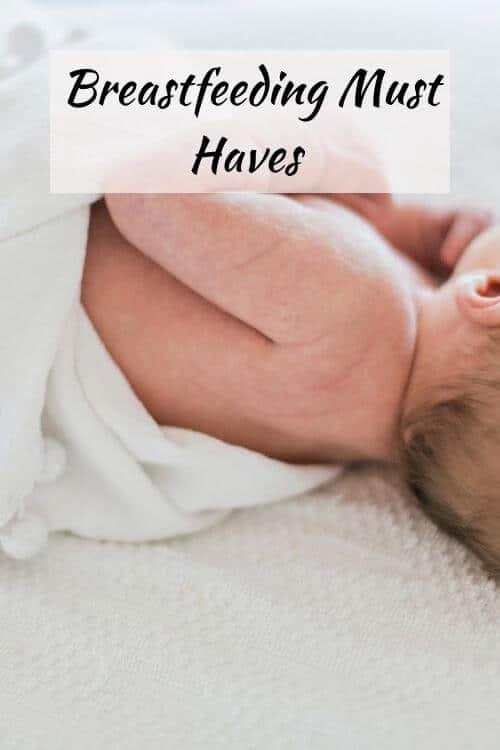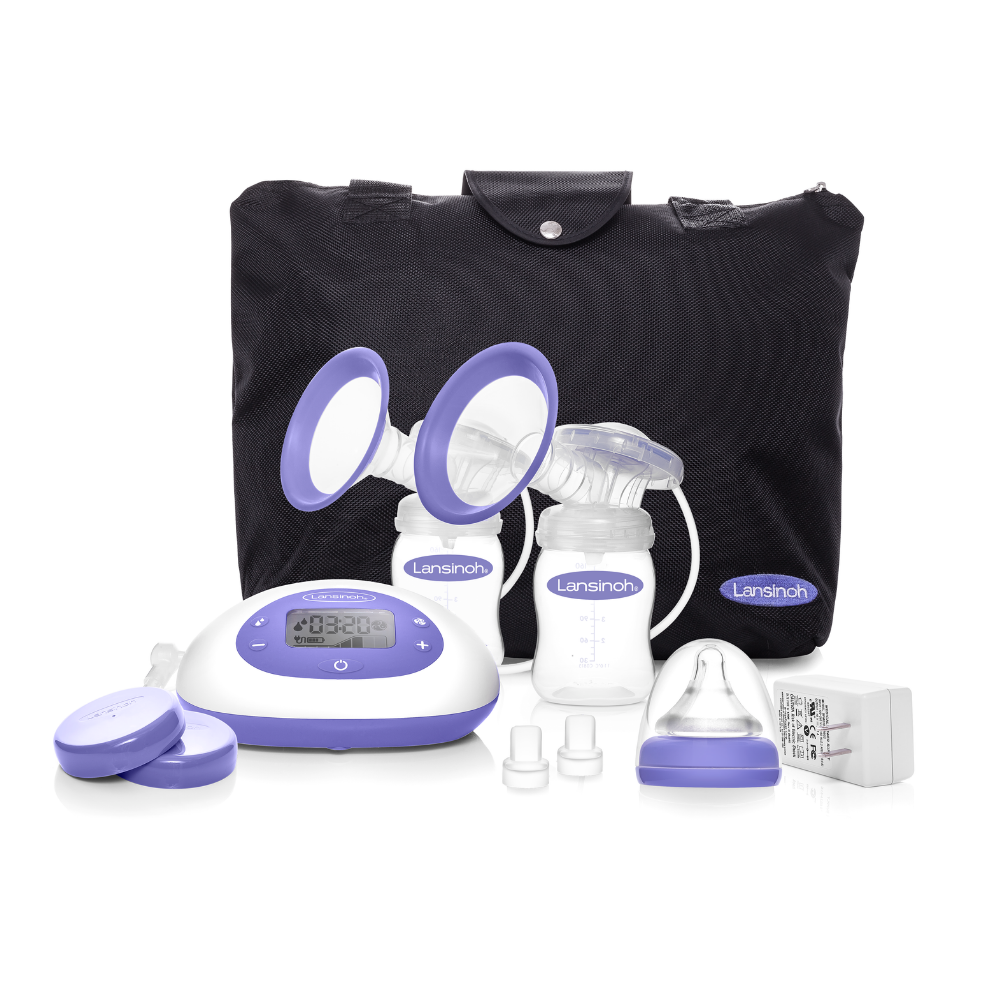Wondering how to best prepare for breastfeeding as a new mom? Cover all your breastfeeding bases with these 23 breastfeeding essentials.

With my firstborn child, I was ill-prepared for the demands of breastfeeding when he arrived, and (initially) lacked some very key breastfeeding essentials that would’ve made life so much easier.
There were nights of waking up drenched in milk-soaked sheets, hot pink sore nipples, and at times, rock hard, painfully engorged breasts. Phew…glad we made it through.
When it comes to breastfeeding, you’ll need to prepare for unexpected public feeding sessions, leaking nipples, dry nipples, overly full breasts, storing breast milk, and being at your baby’s EVERY beck and call.
Once you spend a little time adjusting to the new experience of breastfeeding your newborn, you’ll find that it’s much less horrific than the nights I just described.
It becomes very comfortable and easy to manage and gives special time for good quality bonding with your baby who is depending on you for their nourishment.
If you want to reach that stage of ease and comfort, there are some breastfeeding essentials you absolutely must have (and keep in your breast pumping station) for an ideal breastfeeding experience.
This post is all about breastfeeding essentials.
This post may contain affiliate links, which means I’ll receive a commission if you purchase through my link, at no extra cost to you. Please read the full disclosure here.
Breastfeeding Essentials For Every Feeding Session:
These are the breastfeeding items I kept on me and by my bedside for EVERY feeding and would not have been able to live without.
1. Nursing Camis

I couldn’t imagine being at home nursing (or in public) without wearing a nursing cami.
The nursing cami will make it very easy to access your nursing bra, and ultimately your breasts, for very convenient breastfeeding.
You just unsnap the breast portion of your top to get to your breasts.
These camis also help prevent you from feeling chilly. If you didn’t have one, then you’d have to lift your shirt or remove it altogether, leaving the majority of your upper body exposed. Your tummy will be less likely to feel uncomfortably cold with a nursing cami since you will have your midsection completely covered instead of being exposed.
Since it’s always a bit chilly in our house, I preferred wearing a cami with an overshirt. It allowed me to stay comfortably warm and easily access my breasts when it was feeding time.
These camis also come in handy for keeping your midriff unexposed during public feedings.
2. Nursing Bras


As a breastfeeding mama, you will most certainly need nursing bras.
They conveniently unsnap and re-snap so you can free your breasts for nursing without having to completely remove your bra or try to uncomfortably pull your breast over the top of the cup of a regular bra.
Removing your bra is an option while at home, but if you plan to go on any excursions with your baby or have guests over, you’ll find that it is much easier to open your bra’s breast lining and easily free your breast for nursing.
Although going braless/topless at home is an option, I wouldn’t advise it. Your breasts are prone to release milk at all times once your milk has come in.
If your breasts are left uncovered, your milk will start to drip all over you. That’s why it’s best (for your comfort and reduced messes) to wear a nursing bra with a nursing pad inside that will absorb the milk that’s constantly seeping from your breasts.
3. Nursing Pads


For the entirety of your breastfeeding experience, you will find breast pads to be an undeniable necessity.
You will experience breast milk leaks for many different reasons, such as the sound of a baby’s cry (any baby, not just yours) or being full or engorged.
Even after shower time, you’re quite likely to find yourself hurrying to your bedroom to quickly put on your bra and breast pads to stop your milk from dripping all over you.
You will definitely want some breast pads to absorb excess milk leakage, especially in the first month of breastfeeding when you’re quite likely to find yourself waking up in a puddle of your milk. (Not very pleasant. Very uncomfortable).
Nursing pads will absorb and conceal spontaneous and unexpected milk flow. You can opt for disposable pads or reusable pads.
I personally purchased both and found that the disposable pads were my preference. They have an absorbent core that can soak up more milk than the reusable pads, which tend to become saturated with milk more quickly and easily, leading to more frequent leaks.
Also, in my experience, I found the reusable pads would stick to my nipples sometimes and leave lots of fuzzies on me when I would remove them.
4. Nipple Cream

Breastfeeding is going to involve a lot more sucking, pulling, and tugging at your nipples than what they’ve ever been subjected to before.
Your nipples are NOT going to be prepared for this, but they will get used to it over time.
In the meantime, your nipples may get cracked, but at the very least, they will get dry and sore. You can ease your discomfort by using nipple cream between feedings to help heal, moisturize, and soothe your nipples.
5. Nursing Pillow

Holding your baby while breastfeeding without extra support is absolutely something that you can do, but I found it much more comfortable to lay my baby on a nursing pillow as she nursed.
Although baby is super small and light, that weight will start to get to you after potentially 20 minutes on the left breast and another 20 minutes on the right.
Lying your baby on the nursing pillow during feedings will take the weight off of your arms and leave a hand free to stroke your baby and dab your baby’s face and chin if you notice milk and drool on them.
I had both pillows, but I strongly preferred the Boppy Pillow over the My Brest Friend Original Nursing Pillow. It was so much faster and easier to put around my waist and lay my baby on. Plus, the softer material was more comfortable on my body and my initially sore boobies.
It also serves a dual purpose because when you’re not nursing, your baby can still lie on it for lounge time, nap time, or tummy time – even as they get older. My baby is 15-months-old and still puts it to use.
But one thing that was more convenient about the My Brest Friend Original Nursing Pillow was the fact that you can buckle it to yourself, allowing you to elevate it to whatever height you need, then buckle and tighten it to keep it secured in that position on your body.
6. Big Cup (for Water)

Drinking plenty of water will help keep your milk supply strong.
The hospital where I delivered my babies provided me with a big 32-ounce cup with a straw to keep filled with water, so I could stay hydrated and help bring in my milk with the additional fluids I was providing my body.
During every feeding session, I drank loads of water. If your hospital happens not to provide one, then this is an excellent option for you to use.
NOTE: If you haven’t stocked up on supplies in the beginning or you’re unsure how long breastfeeding will work for you and don’t want to end up with an overstock of nursing supplies, then try the Starter Set Below.
7. Breastfeeding Starter Set

In the very beginning, if you haven’t had a chance to stock up and prepare for your new breastfeeding journey, this breastfeeding starter kit is a great place to start.
It contains nipple cream, nursing pads, a breast cooling pad, and a nipple extractor (aka nipple everter) to evert flat, semi-flat, or inverted nipples.
Nipple cream for dry, tender nipples. Nursing pads for leaking breasts. A breast cooling pad to soothe sore, potentially engorged breasts. And a nipple everter if your nipples need to be drawn out a bit to make it easier for your baby to latch.
Breastfeeding Essentials for Nursing Moms with Flat/Inverted Nipples:
8. Nipple Shield

If you are a woman who has flat, inverted, or only mildly erect nipples, a nipple shield will be very useful while you nurse. Latching the baby onto your breast will be so much easier with this little device. Keep it close by so you can make breastfeeding a much easier process for both you and your baby.
Aside from helping the baby latch more quickly and easily, nipple shields provide a little extra protection for your nipples. But don’t be fooled; your nipples will still get dry and sore and possibly mildly cracked even while using nipple shields instead of bare nipples. Bare nipples or shielded nipples are in for a ride either way.
There are different size options. You can choose from 20 mm for a smaller nipple or 24 mm for a larger nipple.
The 20 mm shield has a diameter of about a dime’s size at the base (the portion you put directly around your nipple). The 24 mm shield has a diameter of about a nickel’s size at the bottom (the part you put directly around your nipple). Choose whichever you think will fit best, or you can choose both to be safe.
9. Nipple Everter

Another option for moms with flat, inverted, or mildly erect nipples to make latching babies much easier is a nipple everter. It has a suction bulb that allows you to apply suction to the nipple to help draw it out, making it more pronounced and more effortless for baby to latch onto mom’s nipple.
Breastfeeding Essentials That Will Make Life Much Easier:
10. Breast Pump



I found having a breast pump to be very useful while I was at home and work.
While you’re at home, there may be times when your baby hasn’t removed enough milk, or your breasts just happen to be too full of milk. When this happens, your breasts are engorged, and it tends to lead to pain and discomfort. With a breast pump, you can drain your breasts and relieve your discomfort.
Also, if you find that the baby is regularly not draining your breasts very much, then you’ll want to pump to prevent your milk supply from dwindling. If your breasts aren’t being drained of very much milk, your body will notice. Your body will perceive this decreased removal of milk as a lack of demand for milk. It will think it does not need to produce as much milk because the baby must not need that much.
If you are returning to work and plan to continue breastfeeding, you will need a breast pump so that you can remove your milk from your breasts periodically, store it, and create a supply of milk for your baby.
Depending on your insurance, they may provide you a pump for free, or they may cover a portion of the cost and leave you with the balance. If this is not an option for you, you may want to try one of these affordable, good quality pumps.
11. Breast Pump Bra

Whether you’re pumping at home or work, a breast pumping bra will make life so much easier and make pumping feel like much less of a chore.
You’ll find that pumping your milk will be 100 times more convenient when you use your breast pump in conjunction with the breast pump bra.
You can use this bra instead of holding the bottles to your breast while hunched over awkwardly feeling bored for 20 minutes’ worth of suction time.
When I was working and pumping, I could have my hands free to use still a computer or my cell as needed.
While at home, I just really preferred the freedom to channel surf or scroll through social media feed on my phone while pumping.
Having your hands free to do as you want while the bra holds the bottles to your breasts makes the process of pumping seem to go by much faster and easier.
I liked the Easy Expression Bustier by Medela.
Most of the bras I came across only had the option to choose the size in terms of small, medium, large. Usually, this doesn’t work for me because I have very large breasts, and I need to choose my cup size for the right fit.
But with the bra by Medela, I tried the Large because the sizing chart claimed it would accommodate my size. And they were right. The fit was just right for achieving my hands-free pumping goals.
12. Breast Milk Storage Bags

You will need to have breast milk storage bags if you’re planning on building up a supply of breast milk for your baby to have so that your baby can still drink your breast milk while you’re working or having an outing.
More than likely, the number of bottles you have on hand will be limited, and they take up more space. They won’t be efficient for storing large amounts of milk.
You can purchase breast milk storage bags in large amounts for reasonably cheap. They will occupy less space, and you can freeze them.
You can easily dump your pumped milk from the bottle into the bag. The bags seal like Ziploc bags and can be labeled with the date and time they were pumped and the number of ounces each bag contains.
You will want to make sure you keep them labeled, especially as your supply begins to increase, so you can be sure to use the older bags first before they expire.
The storage bags can be frozen or refrigerated. They can also be placed in very warm water if you need to defrost or warm-up the baby’s milk before feeding.
13. Bottles



You’ll need bottles so a caregiver can feed your baby while you’re away. AND if you want dad to have some bonding time with baby during feedings, then he can put the bottles to use as well.
They have these awesomely unique, new bottles by Nanobebe that resemble a breast. It’s like having a little mock breast for your baby to feed on when you cannot put the baby on your actual breast.
They come with a breast pump adaptor that will allow you to pump directly into them, and you can seal them for breast milk storage.
These bottles preserve nutrients, are anti-colic, and provide an easy latch for babies. Also, they cool faster than typical bottles to reduce the possibility of bacterial growth. I like them and the technology behind them.
Before Nanobebe breast milk baby bottles, I found Playtex bottles with liners to be an excellent option.
14. Breast Milk Storage Cooler


A storage cooler will be necessary for any pumping on-the-go that you may do. For instance, if you pumped milk at work or knew you were having a girl’s night without the baby.
These coolers will provide a place to store your milk and keep it cool and fresh until you can get to a refrigerator.
A breast milk storage cooler can also be a convenient way to transport your baby’s daily milk supply to daycare. It will make it ultra-easy for them to store it and keep track of it in their refrigerator.
If your breast pump didn’t come with a travel bag, this cooler comes with a breast pump travel bag.

15. Nursing cover

Nursing covers will provide you with much-needed privacy. You’ll want one of these covers for public feedings or if guests are over.
Anytime you need to feed your baby over the course of an outing, or while you have company over, you will want to have one of these nearby to breastfeed without leaving the two of you exposed.
You could substitute a blanket, but a blanket can easily fall off. In contrast, a nursing cover will be secured around your neck and won’t slip off you. I recommend a nursing cover instead of a loose blanket.
16. Bibs

During feedings, you will find that your baby can get a bit messy at times.
Sometimes their little face and cheeks get covered in milk and saliva.
Or sometimes they just suckle more milk than they need and may hold it in their little mouths for a while before they ultimately spit it out, leaving a mess of milk dripping down their face and neck.
Use a bib during breastfeeding to make cleaning unexpected milk and slobber messes a quick, easy, and convenient process.
I prefer bibs with a snap button as opposed to the velcro bibs. I found that the velcro closure scratched my baby’s neck and left abrasions behind.
Also, the velcro closure bibs are WAY too easy for your baby to remove as they get older.
17. Burp Cloths (or Receiving Blankets)


Your baby will spit up on you for sure at some point. Drape one of these cloths over your shoulder whenever you’re burping the baby or holding the baby upright.
It’s also a good idea to drape it across their torso when they’re lying in your arms – just in case.
Keep a burp cloth nearby while you breastfeed for burping your baby between switching breasts.
I would also use it while holding your baby following a feeding session just in case they spit-up.
Receiving blankets also work well and have more surface area than the burp cloths, but burp cloths are usually thicker.
18. Nursing Shirts






As a breastfeeding mother, you will want attire that allows you to quickly and easily access your milk factory so you can satiate your baby’s grumbling little tummy.
These will need to be worn in conjunction with a nursing bra and, in my opinion, a nursing cami.
There are tons of super cute options. These were some of my favorites.
19. Lactation Cookies and Drinks




A lactation consultant recommended lactation cookies and drinks to help increase my milk supply.
I liked them and noticed a difference when I combined them with as many frequent breastfeeding sessions as I could possibly fit in.
In fact, with my firstborn, I was advised to feed him every 2-3 hours. I would wake him up at hour 3 (if he wasn’t up already) and feed him.
Doing this consistently worked wonders! By the time he was 8-weeks-old, he would sleep 8-10 hours through the night since he had received ample feedings to keep him satisfied for a long, uninterrupted sleep through the night. Let me tell you, it was LOVELY!
20. Nursing Bracelet


You’ll want to make sure you swap back and forth between breasts during your breastfeeding sessions.
If you find yourself forgetting which breast you last fed your baby with, then these bracelets can be helpful reminders.
There may be times when the baby is full enough after some time on just one breast. Quickly remind yourself which breast the baby will need put on for the next feeding with these bands.
They also help track how long the baby ate, how many times, and roughly what time they’ll be due to eat again.
Feed on each for approximately the same amount of time to keep things even and comfortable for your breasts.
I would feed for 20 minutes on the left, then 20 minutes on the right. Then I would start on the left again during the next feeding session.
Breastfeeding Cleaning Supplies:
21. Baby Bottle Brush with Nipple Cleaner


To maintain your baby’s bottles’ cleanliness, you will need a baby bottle brush with a nipple brush.
You can find the two together in a convenient 2-in-1 combination pack so you can easily transition from scrubbing the baby bottle to cleaning the nipple thoroughly.
22. Bottle Dish Soap


Bottle dish soap will be necessary to use with your baby bottle brush and nipple cleaner for a complete clean.
I really liked the convenience of this dish soap. It’s got a nice, handy pump that allows for very convenient spot cleaning.
So if all you need to wash is the baby’s bottle, you can just pump a small drop of this dish soap on the bottle and nipple and clean just what you need at that moment.
23. Bottle-Drying Rack


After cleaning a full load of bottles, nipples, pacifiers, Playtex liners, and nipple shields, you’ll need a place to lay them out and let them dry.
You’ll find that it is better and more sanitary to keep your baby’s dishes washed and dried separately from the family’s dishes, which may be covered in sauces, grease, oils, and who knows what else.
A nice drying rack specifically for baby feeding accessories will keep baby’s items separate and easy to access when things are needed.
And now you are officially prepared for all the items you will need to make breastfeeding your beautiful baby as seamless and hassle-free as possible!





Leave a Reply